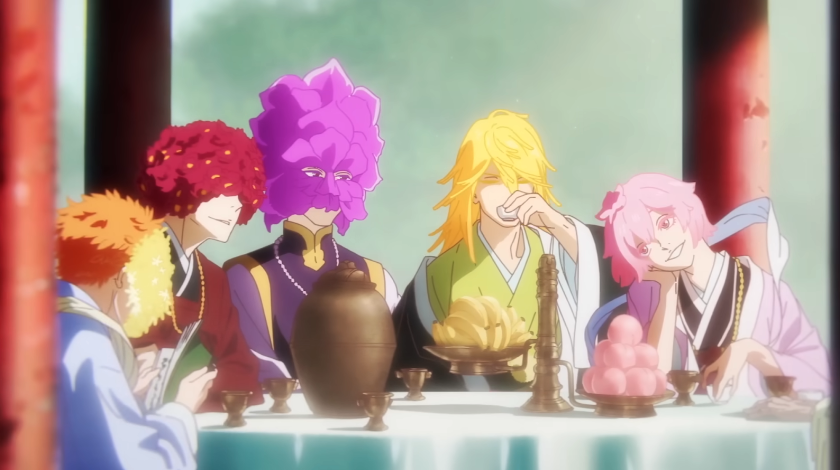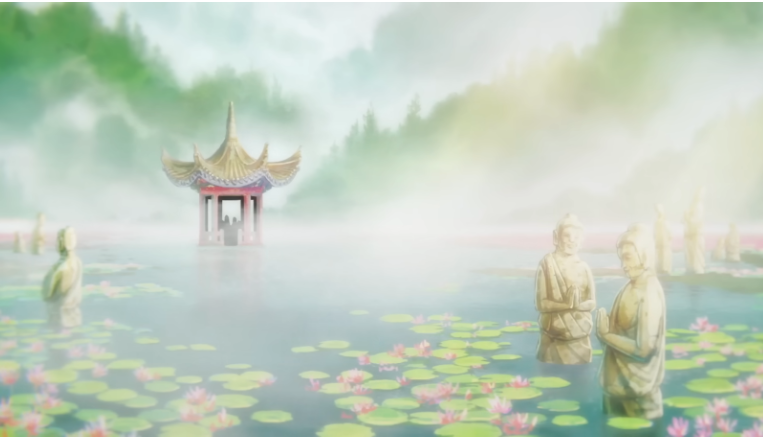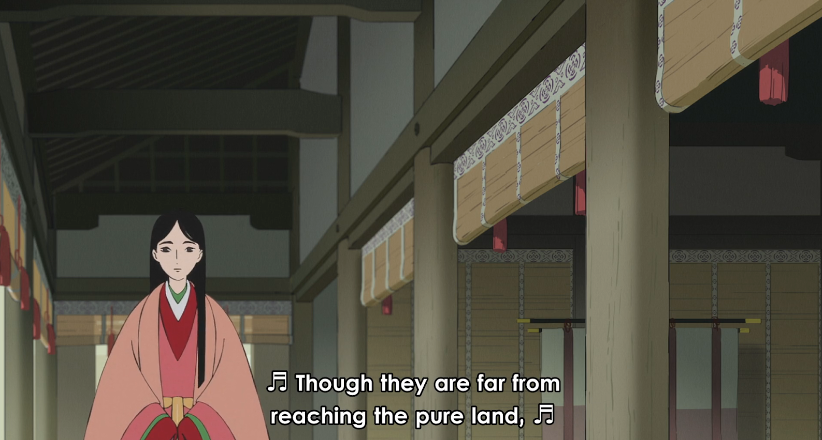By Mahin Gonela

In April 2023, the Japanese anime TV series Hell’s Paradise first aired in Japan. The story, set during the Tokugawa Shogunate era, centers around a death row criminal who accepts a pardon offer in exchange for finding the elixir of immortality in the newly discovered semi-mythical island known as Shinsenkyo. A major aspect of the show that immediately stands out is the prevalence of religious influences, symbolism, and imagery incorporated into the setting and embodied by characters of Hell’s Paradise. For instance, Buddhist and Taoist statues are found across Shinsenkyo, and the inhabitants of the island carry items associated with those religions like the shakujō, a type of staff carried by Buddhist monks. Several characters are also named after important religious figures. The Tensen, the primary antagonists of the show, have aliases which reference major figures in Buddhism: Tao Fa is known by the alias Ratna Taisei, and Ju Fa has the alias Ashuku Taitei. Both of these aliases refer to different Buddhas in the Mahayana and Vajrayana sects. What may not be obvious at first however, is that many of these religious figures and concepts originate in India, not Japan. The historic cultural influence of India on Japan is incredibly significant yet is often overlooked in contemporary conversations about Japan. Modern anime, such as Hell’s Paradise, The Heike Story, and Noragami act as a unique lens through which this cross-cultural influence can be examined.
Within Hell’s Paradise, perhaps the most prominent example of Indian influences is the name of the show itself, which in Japanese is Jigokuraku. The title is a play on words, combining the Japanese words jigoku (hell), and gokuraku (paradise). Gokuraku comes from a Chinese translation of the Sanskrit word Sukhavati, meaning blissful. Sanskrit is a language that was historically spoken in South Asia and used as the primary liturgical language for many early Buddhist texts. Tensen character names from Hell’s Paradise further illustrate this cross-cultural influence. The alias of Tao Fa, Ratna Taisei, is a reference to Ratnasambhava, a Buddha first mentioned in the Suvarnaprabhasa Sutra. This sutra, or composition of literary texts, was originally written in India in Sanskrit. The alias of another Tensen, Mu Dan, is Enthroned Amoghavajra. Amoghavajra was a Buddhist monk of Indian origin who translated many Buddhist texts into Chinese and helped establish the religion in East Asia. Amoghavajra’s journey is a perfect example to illustrate how Buddhism and Sanskrit eventually spread to Japan from India.

Buddhism as a religion was founded by Siddhartha Gautama, who lived in Northern India between 563 and 483 BCE. The religion developed from the social traditions of Hinduism, the dominant religion of India. The two religions share many core concepts and terms, including karma, nirvana, and dharma. After establishing itself in India, Buddhism quickly spread to other regions of Asia. Several Indian monarchs and monks were instrumental in facilitating the early dissemination of Buddhism. The Mauryan Emperor Ashoka, who ruled from 268-232 BCE, sent a diplomatic mission led by his son Mahinda to Sri Lanka to establish the religion there. Later, Kanshika I of the Kushan Empire patronized Buddhism and enabled its transmission along the Silk Road during the 2nd century CE. As a result of these efforts, Lokaksema, a Kushan monk born during Kanshika’s reign, traveled to China to translate several Buddhist texts from Sanskrit to Chinese, laying the groundwork for Buddhism to spread in the region. By the time of the Sui and Tang dynasties of China, Buddhism had been established as a state religion, due in part to the work of Indian monks like Amoghavajra, who brought over more Buddhist scriptures from South India and Sri Lanka. From China, Buddhism spread through Korea to Japan, where it became the state religion during the Nara period (710-784 CE). Even in Japan, Indian monks played a direct role in transmitting Buddhist teachings. One key figure was Bodhisena, an Indian monk from Madurai who traveled to Japan in 736 CE, where he helped establish the Kegon school of Buddhism.
Such efforts enabled Buddhism to become one of the two major religions in Japan alongside Shintoism. As of 2021, over 46% of the Japanese population were adherents of Buddhism. The prevalence and impact of Indian religion in Japan cannot be understated, with there being tens of thousands of Buddhist temples scattered throughout the entire country. Even one of the most famous Japanese philosophies, Zen, developed from Indian Buddhism. The term Zen itself derives from a Chinese transliteration of the Sanskrit term dhyāna (meditation).
Apart from Zen, various other Buddhist traditions in Japan can trace their origins to India as well. For instance, Pure Land Buddhism is a school that believes that rebirth in the Amitabha Buddha’s Pure Realm, the Western Paradise of Sukhavati, is attainable to those who sincerely invoke Amithaba’s name in devotion. The school is based upon three sutras, the Amitāyus Vipaśyana Sūtra, Shorter Sukhāvatīvyūha Sūtra, and the Longer Sukhāvatīvyūha Sūtra. The latter two sutras were originally composed in India and later transmitted and systematized throughout the 6th and 7th centuries in China and Japan.Today, Pure Land Buddhism is one of the most widely practiced forms of Mahayana Buddhism in East Asia, and this prevalence has led to it being referenced in various Japanese anime. The idea and terminology of Gokuraku as a paradise, mentioned in Hell’s Paradise, derives from the concept of Sukhavati as a Pure Realm in Buddhism. Gokuraku, sometimes known as Jodo, is also mentioned in The Heike Story, an anime based off of the Heike Monogatari, a historic Japanese epic compiled in the 1300s. In The Heike Story, Taira no Tokuko, the Empress consort of Japan, sings a song lamenting that women cannot reach the Pure Land, a reflection of the historical beliefs of the school. This illustrates both how influential Pure Land Buddhism was historically and its continued prominence in modern Japanese pop culture.

While Buddhism is a major religion in Japan, it is not the only religion. Many Japanese people practice Buddhism alongside Shintoism, incorporating aspects of both faiths in a syncretic manner. This cultural fusion can be seen in the anime Noragami. Noragami takes place in a universe where Japanese Shinto gods exist alongside humans in a parallel world called the Far Shore. Some of the gods depicted in Noragami include the Seven Gods of Fortune, or Shichifukujin. Of the Shichifukujin, three originate from Indian deities: Daikokuten, Bishamonten, and Benzaiten. Daikokuten is a direct translation of Mahakala, a Buddhist deity also associated with the Hindu god Shiva. Bishamonten derives from the Sanskrit name Vaisravana, an epithet of the Hindu god of wealth Kubera. Benzaiten originates from Saraswati, the Hindu god of knowledge, art, and literature. These deities were incorporated from Hinduism into Buddhist tradition in India and then transmitted to Japan, where they became part of the Shinto-Buddhist cultural tradition. The impact of these deities on Japanese society goes beyond representations in media, as there are major temples dedicated to the Shichifukujin in Tokyo, where some local residents go on yearly pilgrimages to these places of worship.

Japanese culture is typically viewed as being incredibly influential in its own right, with aspects of Japanese history, cuisine, language, and art having made major impacts on Western culture in the past few decades. However, it remains important to remember that Japan itself has been influenced by other cultures in the past. The presence of Indian religious and linguistic elements in recent Japanese anime is just another reminder of the shared linguistic, religious, and philosophical history between South and East Asia.
Photo Credit: Mahin Gonela. Screenshots from the Noragami, The Heike Story, and Hell’s Paradise episodes.

